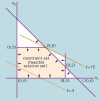A Review of the Use of Linear Programming to Optimize Diets, Nutritiously, Economically and Environmentally
- PMID: 29977894
- PMCID: PMC6021504
- DOI: 10.3389/fnut.2018.00048
A Review of the Use of Linear Programming to Optimize Diets, Nutritiously, Economically and Environmentally
Erratum in
-
Corrigendum: A Review of the Use of Linear Programming to Optimize Diets, Nutritiously, Economically and Environmentally.Front Nutr. 2022 May 13;9:850033. doi: 10.3389/fnut.2022.850033. eCollection 2022. Front Nutr. 2022. PMID: 35634406 Free PMC article.
Abstract
The "Diet Problem" (the search of a low-cost diet that would meet the nutritional needs of a US Army soldier) is characterized by a long history, whereas most solutions for comparable diet problems were developed in 2000 or later, during which computers with large calculation capacities became widely available and linear programming (LP) tools were developed. Based on the selected literature (52 papers), LP can be applied to a variety of diet problems, from food aid, national food programmes, and dietary guidelines to individual issues. This review describes the developments in the search for constraints. After nutritional constraints, costs constraints, acceptability constraints and ecological constraints were introduced. The 12 studies that apply ecological constraints were analyzed and compared in detail. Most studies have used nutritional constraints and cost constraints in the analysis of dietary problems and solutions, but such research begin showing weaknesses under situations featuring a small number of food items and/or nutritional constraints. Introducing acceptability constraints is recommended, but no study has provided the ultimate solution to calculating acceptability. Future possibilities lie in finding LP solutions for diets by combining nutritional, costs, ecological and acceptability constraints. LP is an important tool for environmental optimization and shows considerable potential as an instrument for finding solutions to a variety of very complex diet problems.
Keywords: diet costs; environmental constraints (EC); linear programming; nutritional quality; sustainable diet.
Figures



Similar articles
-
Diet affordability: a key dimension in the assessment of sustainable food systems and healthy diets.Front Nutr. 2024 Aug 12;11:1399019. doi: 10.3389/fnut.2024.1399019. eCollection 2024. Front Nutr. 2024. PMID: 39188980 Free PMC article. Review.
-
Corrigendum: A Review of the Use of Linear Programming to Optimize Diets, Nutritiously, Economically and Environmentally.Front Nutr. 2022 May 13;9:850033. doi: 10.3389/fnut.2022.850033. eCollection 2022. Front Nutr. 2022. PMID: 35634406 Free PMC article.
-
Can micronutrient requirements be met by diets from sustainable sources: outcomes of dietary modelling studies using diet optimization.Ann Med. 2024 Dec;56(1):2389295. doi: 10.1080/07853890.2024.2389295. Epub 2024 Aug 11. Ann Med. 2024. PMID: 39129219 Free PMC article. Review.
-
Optimisation modelling to improve the diets of First Nations individuals.J Nutr Sci. 2019 Sep 20;8:e31. doi: 10.1017/jns.2019.30. eCollection 2019. J Nutr Sci. 2019. PMID: 31595187 Free PMC article.
-
Planning dietary improvements without additional costs for low-income individuals in Brazil: linear programming optimization as a tool for public policy in nutrition and health.Nutr J. 2019 Jul 20;18(1):40. doi: 10.1186/s12937-019-0466-y. Nutr J. 2019. PMID: 31325970 Free PMC article.
Cited by
-
Diet affordability: a key dimension in the assessment of sustainable food systems and healthy diets.Front Nutr. 2024 Aug 12;11:1399019. doi: 10.3389/fnut.2024.1399019. eCollection 2024. Front Nutr. 2024. PMID: 39188980 Free PMC article. Review.
-
Mathematical optimisation of extruded mixed plant protein-based meat analogues based on amino acid compositions.Curr Res Food Sci. 2023 Dec 5;7:100648. doi: 10.1016/j.crfs.2023.100648. eCollection 2023. Curr Res Food Sci. 2023. PMID: 38115894 Free PMC article.
-
Combining Plant Proteins to Achieve Amino Acid Profiles Adapted to Various Nutritional Objectives-An Exploratory Analysis Using Linear Programming.Front Nutr. 2022 Feb 3;8:809685. doi: 10.3389/fnut.2021.809685. eCollection 2021. Front Nutr. 2022. PMID: 35187024 Free PMC article.
-
Bi-objective goal programming for balancing costs vs. nutritional adequacy.Front Nutr. 2022 Dec 15;9:1056205. doi: 10.3389/fnut.2022.1056205. eCollection 2022. Front Nutr. 2022. PMID: 36590216 Free PMC article.
-
Developing a Food Exchange System for Meal Planning in Vegan Children and Adolescents.Nutrients. 2018 Dec 25;11(1):43. doi: 10.3390/nu11010043. Nutrients. 2018. PMID: 30585248 Free PMC article.
References
-
- FAO . How to Feed the World in 2050. Rome: FAO; (2010).
Publication types
LinkOut - more resources
Full Text Sources
Other Literature Sources

